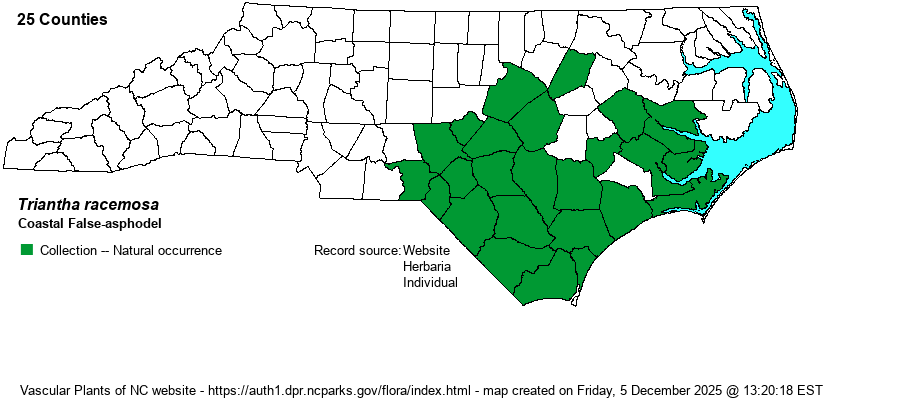| Author | (Walter) Small | |
| Distribution | Occurs throughout the southern half of the Coastal Plain, including the Sandhills region, very similar in range to the visually similar Tofieldia glabra. It does range sparingly into the extreme eastern edge of the Piedmont (e.g., Nash and Wake counties), though it may well be extirpated from this province.
This is a Southern Coastal Plain species, for the most part, ranging north to NJ and south to northern FL, and then west to eastern TX; disjunct to central TN. | |
| Abundance | Infrequent to fairly common in the coastal counties. Farther inland, it is generally uncommon, though usually more numerous than Tofieldia glabra where both are present, despite both being given a State Rank of S4. It is extremely rare in the eastern edge of the Piedmont. It is one of the more frequently encountered "lilies" in savannas of the coastal counties, though few savanna species are given a State Rank of S5 owing to habitat loss and the need for frequent fire to keep populations healthy. | |
| Habitat | This is generally a species of pine savannas, occurring not only in the wetter portions but also in the drier portions as well. It also occurs along pocosin margins, scrapes in savannas, and in Sandhills seeps and streamhead ecotones. |
| Phenology | Blooms from June into early August, and fruits from late September through October. The very similar Tofieldia glabra, which often grows with or near it, blooms mostly about two months later, generally in late September and October. | |
| Identification | This species has a grass-like appearance when not in bloom, with a basal cluster of narrow leaves growing to about 9-12 inches tall. The flowering scape, growing to about 15 inches tall, is very rough to the touch, with the upper 3 inches containing the very dense cluster of small white flowers. The cluster is a thyrse, meaning that the flowers (each about 1/4-inch across) are arranged in groups of two or three coming off the stem at the same point, yet the "test-tube brush" of flowers looks remarkably similar to the singly-arranged flowers of Tofieldia glabra at any distance. Separation of these two species is easy: 1) Triantha blooms in summer, into August, whereas Tofieldia blooms in fall; 2) Triantha has a rough scape whereas Tofieldia has a waxy-smooth flowering stem; and 3) the flower cluster of Tofieldia is a raceme and not a thyrse. When you are visiting a savanna in summer, this will often be a species you encounter in bloom; when visiting in fall, you can still spot the cluster of capsules on the scape, but it is the Tofieldia that will be in bloom in late September and October. In the Mountains, any Triantha there should be T. glutinosa; separation of the two is based on capsule and seed characters. | |
| Taxonomic Comments | Until fairly recently, the two NC species of Triantha were included in the genus Tofieldia. When RAB (1968) was published, Tofieldia racemosa consisted of two varieties, the Coastal form (T. racemosa var. racemosa) and the montane form (T. racemosa var. glutinosa).
| |
| Other Common Name(s) | Southern Bog Asphodel, Coastal Plain Bog Asphodel | |
| State Rank | S4 | |
| Global Rank | G5 | |
| State Status | | |
| US Status | | |
| USACE-agcp | OBL link |
| USACE-emp | OBL link |

